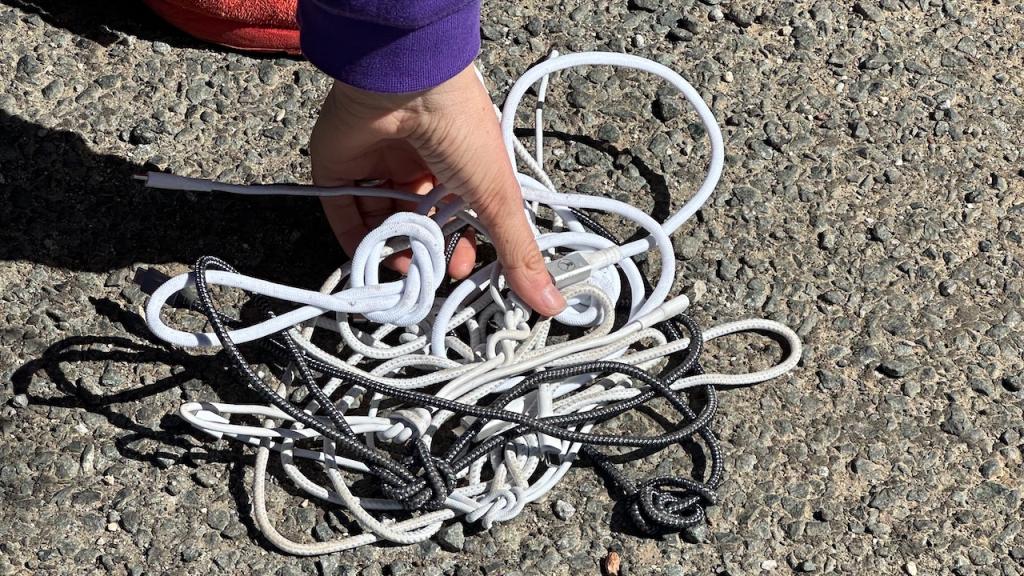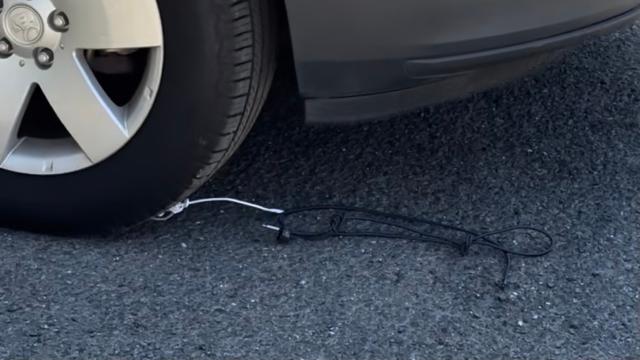Now, you might have looked at that headline and thought “oh good! This article is going to talk about the data transfer speeds for using USB-C cables with the iPhone 15 Pro.” While I hate to disappoint you, this article is actually about running stuff over with cars in the name of science.
You see, over the years I’ve seen dozens of cables talk about how they’re so big and strong and made of Kevlar that they couldn’t possibly break. Then I proceed to break all of them surprisingly quickly.
Years ago I tested “tough” cables by making increasingly heavier family members do pull ups with cables (after I got kicked out of my gym for trying to use weights). But that also isn’t really an accurate test of a cable’s strength, because you don’t break cables because you pull them too hard, but because you screw them into little balls, squish them up, and then put stuff on them.
So, I decided that the best way to simulate a few years of use of cables (without having the benefit of a lab) would be to tie a bunch of really nice, expensive cables into tight knots and then run them over with a car, repeatedly.
This probably goes without saying, but for a whole range of reasons, I do not recommend tying your cables in knots and then running them over with a car.
Tough iPhone-ready USB-C Cables Tested

It was important to test a cross section of cables, from cheap $19.99 to fancy, fast charging and data moving $69.99.
These were our contenders:
- Apple USB-C cable that came with my AirPods Pro ($29)
- Bonelk Long Life Series USB C cable ($69.99)
- Satechi USB C to USB C cable ($39)
- Belkin BoostCharge USB C to USB C ($27.95)
- Belkin BoostCharge USB C to USB C 100 W braided cable ($26.80)
Tough USB-C Cable Testing Method: Be Prepared
When my mum was a child, she was in the Girl Guides and the Brownies, and earned a knot tying merit badge. Even though cable care was part of my VET Music course in high school, so I’m good at taking care of cables, I actually suck at tying non-crochet-related knots, so mum was tasked with tying the cables into two different knots (one at each end). One was a vaguely complicated one from a knot tying book, and one more simple one that the cable will probably tie itself into while in your bag, just to spite you and everything you love.
We then tested them all to make sure that none of the connections were broken in the knot tying process. All was fine.
The next step was braving the truly impressive number of spiders that had recently hatched in my dad’s car. This is not relevant to the cable testing, but I do need you to understand the sacrifices we made to bring you this test. Dozens, if not hundreds of spiders.
We drove down to the laneway near my parents’ house, and set the cables in a neat, straight line in front of the tyres to make sure they all got run over evenly. Sadly, despite my best efforts while attending a fundamentalist Christian high school in the early 2000s, I have never managed to do anything straight in my entire life. Although I reversed back and forth and tried to drive straight, the first couple of attempts missed the Apple cable. The other cables got quite run over, but I just missed the third in line on the left tyre.
The best solution I could come up with was to bundle all the cables together in one kind of monstrous ball, and drive over them again. This time, I absolutely 100% got all of them. But, to be sure, I went back over them a few times, just to really grind them into the poorly maintained asphalt.
Tough iPhone USB-C Cable Testing Results

Surely, surely tying the cables into knots and then running them over repeatedly with a car would kill all of these cables, right?
The Bonelk appeared to have been run over the best, with the cable ends looking a bit dented. Though, running a close second was the Apple cable, which looked mostly fine on the body, yet a bit squished on the connector. But, disappointingly, none of the cables burst open like they did during the chin up stress tests. I wanted to see cable guts.
There was gravel there. The car is a heavy Holden Captiva 7 covered in moss that occasionally starts to grow a small tree in the fabric of the boot. This is not a light car. But no guts.
The cable I was most certain was going to die was the Belkin BoostCharge USB C to USB C, the least tough looking cable of the bunch. It definitely no longer looks quite right, there are dents in the plastic, and parts of the wiring never fully unbent from the knots, but it still works. I doubt it has long for this word, and I think any further day-to-day trials may kill it fully, but I had assumed it wouldn’t survive being tied up once, let alone being fully run over by a car.
Yet, it worked.
In fact, all five cables survived the experience. They all have obvious dirt and dents, but all managed to charge our test iPad. Even the thin Apple cable, with its squished USB-C jack, which I assumed wouldn’t attach anymore, still worked just fine.
Obligatory Safety Warning

Now, it’s important that I say this: if you have a cable with visible damage, like you can see the cable’s innards, or there’s fraying, or the end is squished, you should put it in an ewaste bin and stop using it immediately. Sure, it probably won’t catch fire, but you have a much, much higher chance of it catching fire or electrocuting you, or damaging your device, that it’s really not worth the risk when new cables are so plentiful. While I would not describe any of this test as being done under controlled conditions, I did these tests with a fire extinguisher nearby, in an apocalypse bunker designed to withstand bushfires.
It is not worth damaging the port of your $1500 phone, or risking starting an electrical fire in your house to avoid replacing a $20 cable.
Verdict
What did we learn from this? Hard to say. But I think my takeaway is that USB-C cables are surprisingly strong. Over the years I’ve broken a lot of cables in a lot of ways, and 10 years ago I don’t think any of my cables would have survived what I put these ones through.
So, I guess, if you do want a tough cable, or you find yourself in a position where you have cables tied in a knot and then run over by a car, all of these are good choices.
